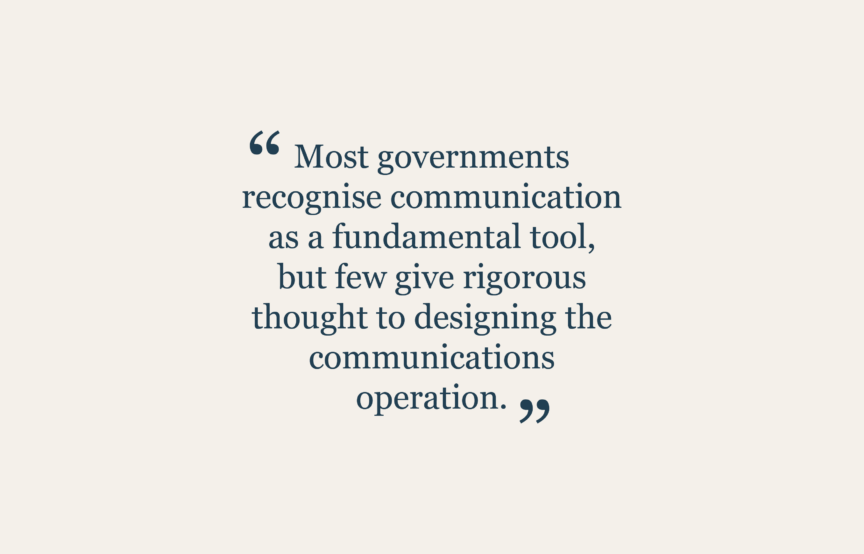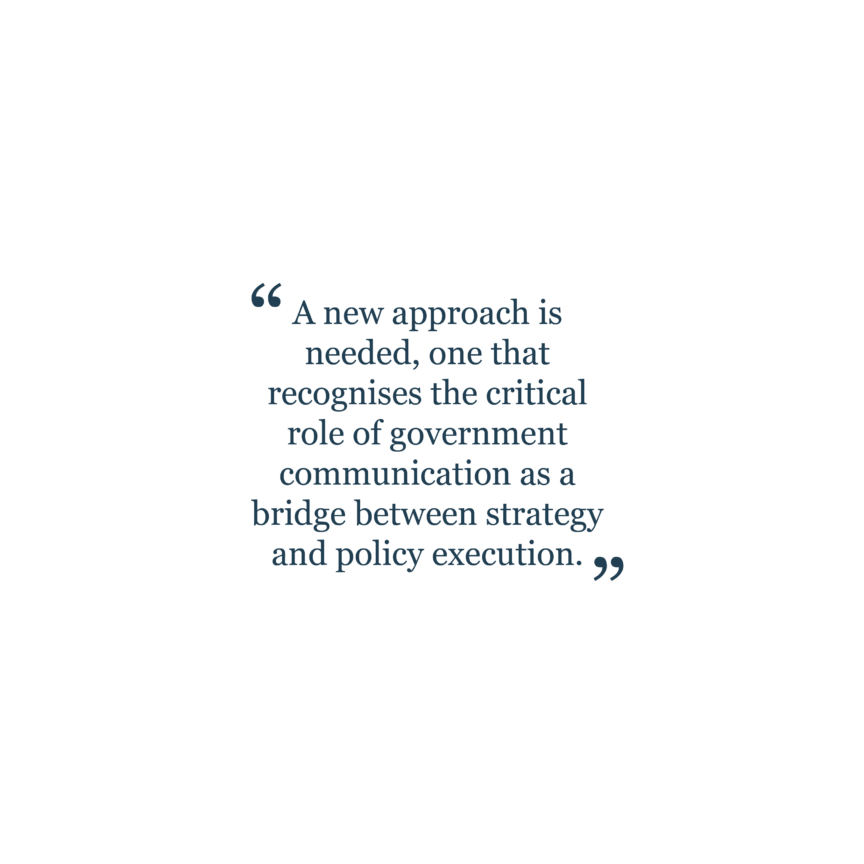Mission critical:
A new approach to designing government communications for success
By David Bishop, Ahmed Iqbal and Calum Bardsley

Structuring government communications to meet complexity
Effective communication is mission critical for governments. It has a vital role to play in every aspect of governance – whether launching a new policy, celebrating targets achieved, calling for input to a public consultation, attracting investors and tourists or engaging with foreign administrations.
Governments operate in a complex, constantly shifting domestic and global context, driven by geopolitics and socio-economic trends, fluctuations in public opinion, technological change and political rivalries. Good comms can help governments navigate these currents as they pursue their own agendas. Conversely, a trivial mistake – the wrong photo in a tweet, a careless word to a journalist – can trigger a backlash or derail a strategy.
Most governments recognise communication as a fundamental tool, but few give rigorous thought to designing the communications operation. Indeed, it’s often viewed as an afterthought, not a full partner in strategy development. This is a mistake – one with potentially costly and career-defining implications.
Great government communication flows from an organisation in which structure, process, skills and culture are all aligned to strategy. This cannot be achieved by accident: it must be purposefully designed. Here, we explore the key steps in building a comms strategy for our challenging times.

Why does good communication matter for governments?
Communication is one of the main levers that a government can use to advance a strategic agenda – and it fosters an environment in which other levers can operate. Any law, regulation or tax must be communicated to the people, in a way that wins support and understanding.
But government comms plays many other roles too. It eases policy implementation, shapes consensus and enables advocacy. And it connects leaders with the public – building a persona, setting out motivations and mobilising supporters.
Most importantly, perhaps, good communication builds trust, and signals transparency, accountability and responsiveness. Research by the OECD and World Bank demonstrates that trust in government is directly correlated to better social and economic outcomes.1
Communication also matters on the global stage. A country seeking to attract foreign direct investment or welcome tourists must be able to sell itself convincingly to the world.
Case study 1: Saudi Arabia’s cultural communication strategy
Saudi Arabia has a rich cultural history that reaches back over thousands of years. Recognising the importance of this heritage, in 2018 the government, under Saudi Vision 2030, established a dedicated Ministry for Culture.2
The goal was to use culture as a means to promote social and economic development. To achieve this, the Ministry needed to communicate these initiatives, and the value of Saudi culture, to a local and global audience. Consulum advisors contributed to designing a communications department for the Ministry that ensured that their strategy, tailored to Saudi Arabia’s unique cultural context, also took into account global best practices.
The new comms strategy effectively highlighted the significance of Saudi’s cultural sector, resulting in measurable improvements in understanding and appreciation among the general public. This case underscores the importance of clear and efficient communication for governments, especially when aiming to foster cultural understanding and promote national initiatives.

The simplest thing is difficult
The 19th-Century Prussian general Carl von Clausewitz once wrote: “Everything is very simple in war, but the simplest thing is difficult” – an observation that might sound familiar to government communicators.3 Governing is hard, in ways that make communications complex:
-
Governments operate in a challenging, constantly changing context.
Geopolitical factors shape the broad environment of peace and war, cooperation and competition. Socioeconomic trends bring opportunity and threat. New technology (like AI) creates industries, but may contribute to destabilisation – for example, through social-media manipulation.
-
This environment looks set to grow only more turbulent.
The WEF’s Global Risks Report 2023 highlights familiar risks (inflation, trade wars, geopolitical tensions) alongside new and mounting challenges like rising debt, deglobalisation and climate change.4
-
The scope and variety of government activities makes coordination hard.
On any given day, you may welcome a foreign dignitary, reach a trade agreement, tackle a cyber-attack, introduce new legislation, or respond to public questioning. All this, in addition to day-to-day service delivery.
-
Ministries do not always cooperate smoothly, and not all information gets shared.
Even within a single department, teams can become siloed.

-
The interplay of politics and policy is also significant.
Agendas and ideologies will not always align with the needs of effective, evidence-based policy and communications.
-
Communications staff don’t always have the required skills or capabilities.
HR rules that limit headcount reduction, for example, can mean that inexperienced people are transferred into comms teams.
-
Governments can become risk-averse.
Government leaders must make hard decisions, with serious short- and long-term consequences for lives and reputations. Faced with such high stakes, they may postpone tough choices or use communication to hide things from the public rather than shed light.
—-
With all this complexity, it’s hard to communicate. Strategy, policy and communications can easily fall out of alignment, meaning that policy is not delivered effectively. Errors, criticism and failures can negatively impact strategy – and the careers of those involved.
Case study 2: Damage control in Australian schools
In 2022, the Australian government was facing a dilemma. The government funds both state and private schools on a per-student basis.5 However, the budget papers indicated only total funding to each sector. This might easily be misinterpreted as indicating that the new Labor government was boosting funding to the richest private schools.
The communications advisory team (which included a Consulum colleague) realised this risk. It was too late to change the budget papers, and so they needed to be explained. The team leapt into action.
Nothing could be done prior to the budget release, but it was imperative to brief stakeholders – especially the Australian Education Union – immediately thereafter. A list of stakeholders was promptly drawn up and called. All education journalists were contacted, and simple, short messaging was prepped for media interviews. The caucus, too, was briefed and provided with local factsheets and digital assets.
Here, several factors – the internal complexity of the federal government, a challenging operating context which included critics waiting to pounce, and a lack of specialist comms skills – meant that strategy, policymaking and communications were not well integrated.
The rapid, coordinated response quashed a potential uproar. But it would have been preferable to apply foresight, thus enabling better planning, decision-making and communications. After all, it is far more effective to avoid a crisis than to limit its impact after the event.

Setting the stage for successful communication
Successful organisations know that design is integral to performance. But it’s rare for a government to apply this approach to communications operations.
Government bodies are structured in different ways. Some are traditionally organised institutions, which may have developed over several decades. This is often the case in Western governments, where hierarchies of officials are arranged into ministries, departments or directorates, each with well-defined responsibilities and procedures.
In other administrations – particularly in developing and emerging economies – ministries and departments are often designed by management consultants, following models inspired by the business world.
In both systems, comms is often viewed as just another function within a ministry, not closely connected to strategy or policymaking. This is a fatal flaw. These arrangements do not account for the unique role that communication plays in modern government, the growing challenges governments can expect to face, or the pace of change.
A new approach is needed, one that recognises the critical role of government communication as a bridge between strategy and policy execution.
Consulum’s ACE model
Consulum advisors have wide-ranging experience with governments around the world. This has helped us design our three-step ACE (Assess, Create, Embed) methodology for communications transformation.
ACE is informed by global best practice, the principles of organisational design, and a real-world understanding of what works in this unique and challenging environment:
Assess
Agree on a clear vision of what you aim to achieve, aligning purpose and strategy. Next, rigorously assess your current situation and the barriers to overcome.
Create
A communications team or organisation needs an effective operating model. This is much more than an organisational structure. It sets out a comprehensive system of governance and accountability, capability and people, processes and workflows, performance, reward, culture and values. This then informs organisational design.
Embed
This is focused on the human elements of a communications organisation: capability development, with tailored training and upskilling to enable the uptake of new tools such as AI monitoring or analysis. It also focusses on values, culture and performance, essential for embedding improvements for the long term.

Many comms transformation programmes focus on the “hard” elements addressed in the Create phase – structure, roles and processes. While these are essential, an approach that does not engage with “soft” human factors is unlikely to succeed.
Much has been written about the difficulties of “designing” an organisational culture. But it is possible to introduce mechanisms that help to shift mindsets, producing more agile, adaptable, future-fit organisations.
We’ve identified five behaviours that are key to the successful transformation of government communication:
1. Horizon scanning
Proactively predicting and monitoring trends and challenges.
2. Scenario planning
Strategically preparing for possible future outcomes.
3. Evidence-based approaches
Basing decisions on solid data grounded in research.
4. A collaborative mindset
Promoting clear, open communication and sharing of ideas at all levels – within ministries, across government and internationally.
5. A clear ethical framework
Establishing moral guidelines for transparent and trustworthy communication.
Case study 3: Long-term planning – preparing for future communications in Malaysia
In 2015, the National Strategy Unit (NSU) was formed in the Malaysian Ministry of Finance to coordinate strategy, policy and communications across the National Blue Ocean Strategy (NBOS) programme.6
The unit oversaw and reviewed initiatives, made strategic recommendations and ensured that cross-ministerial collaboration was embedded across projects. It gave advice on communications – recommending, for example, engaging international bodies such as the World Bank to showcase the NBOS.
The advisory team (including a Consulum colleague) not only helped create the structure for the NSU but also developed a methodology and framework for its operation. Ongoing skills development was considered too, with in-person training aligned to methodology and target organisational culture. The creation of an online course covering NBOS principles and tools, with case studies and practical exercises, helped to ensure that its impact would be felt well into the future.
This was a model of a comprehensive, integrated approach, with hard and soft elements incorporated into a clear operating model. Deliberate organisational design was a crucial step, along with building the skills and capabilities of the NSU team – creating an organisation fully able to deliver on its mission.
A successful government communications operation is the product of deliberate design. It aligns an organisation’s purpose, strategy and operating model. Too often, government leaders neglect this process. But in challenging times, mission-critical communications can mean the difference between success and failure for governments seeking to connect – with their people, and with the world.

About the authors
David Bishop
David leads Consulum’s capacity-building practice. Passionate about helping governments communicate effectively to drive strategic success, he has almost two decades of experience leading strategic communications teams, as well as strategy and organisational design projects for a range of government organisations including Expo 2020 Dubai, VisitBritain and ministries in Saudi Arabia.
Ahmed Iqbal
Ahmed is a government-relations and organisational-design specialist. He has experience across a range of UK government departments, including having led European bilateral relations at the UK Department for Business, Energy and Industrial Strategy. He was also Head of Business Engagement Strategy at the Department for International Trade, where he played a leading role in the development and delivery of the UK’s Trade Advisory Groups.
Calum Bardsley
Calum is a capacity-building and organisational-design expert who has worked extensively with major private-sector organisations in the UK and Middle East. Prior to joining Consulum, he supported the delivery of the post-merger integration of Virgin Media O2, one of the largest mergers in Europe’s telecommunications industry. He previously helped deliver business-transformation programmes for Sky and PwC, assessing operating landscapes to ensure strategic objectives were achieved.
References
[1] “Trust in government”, Organisation for Economic Co-operation and Development, org, 2023; Andrews, D. et al., “Trust – necessary fuel for effective governance”, Governance for Development, World Bank Blogs, 11 January 2022.
[2] “Saudi Culture Ministry formed following a major Cabinet reshuffle”, Arab News, 2 June 2018; “Saudi Vision 2030: The story of transformation”, vision2030.gov.sa.
[3] Carl von Clausewitz, On War, 1832
[4] Published 11 January 2023
[5] Rosie Clarke, “Gov funding for private schools up $3338 per student vs $703 for public schools”, School News Australia, February 16, 2022.
[6] “Breaking Down Silos: Malaysia’s Experience in Strengthening Inter-agency Cooperation”, Case Study 2, Improving Public Sector Performance, World Bank Group, Global Knowledge and Research Hub in Malaysia.
